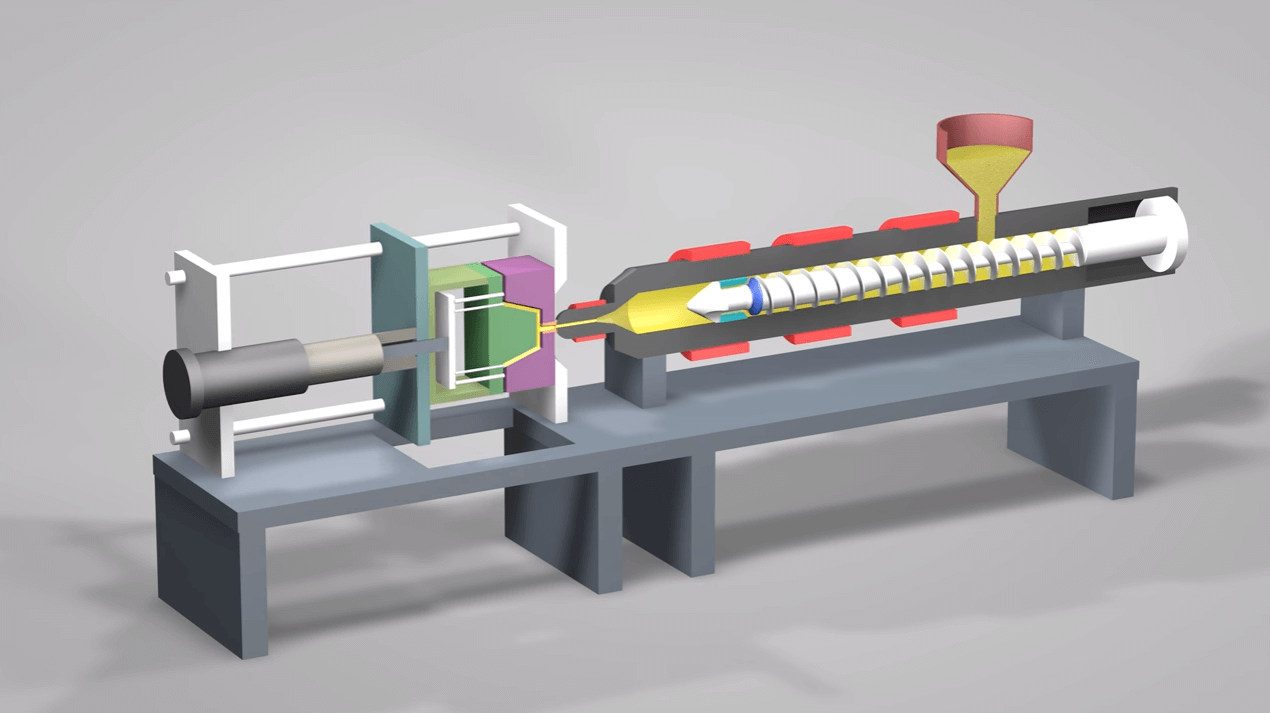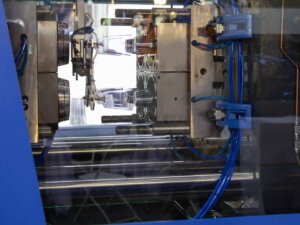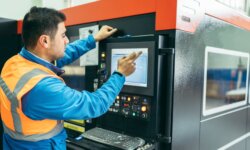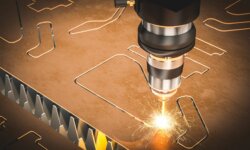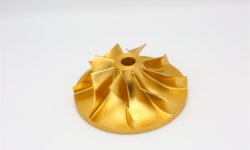Injection molding is the go-to manufacturing process for the mass manufacture of plastic parts. Central to the molding process is the plastic injection molding machine, a large piece of machinery that consists of two parts, an injection unit and a clamping unit.
The injection molding process is fast, accurate, highly repeatable, and extremely cost-effective in large quantities. It is used by countless manufacturers in areas like automotive, consumer goods, packaging, appliances, and the industrial sector. Its value as a high-speed process lies in its use of durable metal tooling or molds: once a mold has been fabricated, the cycle time for each “shot” of plastic can take as little as 30 seconds.
However, injection of plastic into a metal mold cannot be done manually. Instead, an injection molder — a skilled professional who makes moldings — will use a complex piece of equipment called an injection molding machine (spelled ”injection moulding machine” in the UK and some other countries) which is capable of filling a mold with a great amount of force.
This article makes an in-depth examination of the injection molding machine, looking at its constituent features and how they work together to make molded parts.
What do injection molding machines do?
By definition, molding processes make parts via the filling of a hollow object called a mold. A mold contains a cavity that is shaped like the desired part. The cavity is then filled with a liquid material, which goes on to solidify within the mold. When the material is removed from the mold, it has become solid and assumed the shape of the mold cavity.
Plastic injection machines are not always necessary for the molding of parts. Low-cost silicone molding, for instance, involves manually pouring a two-part silicone solution into a mold then waiting for it to cure and harden. The soft silicone part can then be manually pulled out of the mold.
Injection molding is a bit different. The liquid material needs to be forced into the mold at very high pressure — something that cannot be achieved with manual pouring — so that it enters the mold cavity quickly and reaches every crevice and corner of the mold. Moreover, the material (usually a thermoplastic) is only in a liquid state because it has been melted down, and the injection molding machine is responsible for melting it.
The purpose of an injection molding machine is therefore to melt down solid plastic into liquid, to inject that liquid into the metal mold at high pressure, and to ensure that the mold does not accidentally pop open due to the high forces involved.
What are the parts of a machine?
An injection molding machine consists of two main parts. These are the injection unit, which is responsible for squeezing the molten material into the mold cavity, and the clamping unit, which is responsible for securely holding the two sides of the mold together during injection and cooling (then releasing them in order to eject the part).
Injection unit
The injection unit of a plastic injection molding machine consists of three main components. These are:
- The hopper containing plastic pellets or other raw material
- The heated barrel
- The reciprocating screw
The hopper is a container in which the raw material — usually in pellet or granule form — is placed.
To make a part, a portion of raw material is dispensed into the barrel below, where heating elements melt the plastic down into a liquid. A screw motor drive turns the large reciprocating screw, which has a variable pitch so it can push the material towards the tip of the barrel, building up pressure, while simultaneously melting the material further.
When the requisite amount of molten material has been pushed to the tip of the barrel and pressure has been built up, a device called a ram quickly pushes the screw towards the mold, forcing the “shot” of plastic out of the barrel and into the mold cavity via a sprue and a system of runners.
Clamping unit
The clamping unit of a plastic injection molding machine consists of three main components. These are:
- The mold
- The clamping motor drive
- A moving and a stationary platen
The runners deliver the molten material via gates into the mold cavity, the space between the two mold halves. The mold halves are called the cavity (the side closest to the barrel) and core (furthest from the barrel). Some molds comprise more than two pieces and may contain a side-action core, for example.
Molds are expensive to make and are typically made of tool steel or aluminum. Tool steel molds generally cost above $5,000 (sometimes up to $100,000), while shorter-life aluminum molds cost less.
The rest of the clamping unit uses high forces to keep the mold closed during injection and cooling, effectively countering the forces of the injection unit. The clamping motor drive and clamping cylinder pushes — using, e.g. hydraulic force — the moving platen (attached to mold core) along a set of tie rods in the direction of the stationary platen (attached to mold cavity). The power of the clamping motor drive determine’s the injection molding machine’s clamping force and clamping tonnage.
When the molten plastic has solidified, the moving platen recedes, opening up the mold, and ejector pins release the finished plastic parts from the mold, usually dropping them into a container or onto a conveyor belt to create a production line.
Types of plastic injection molding machine
Machines vary in size and mode of operation. Some of the most common types of injection molding machine include:
- Hydraulic machines use hydraulic forces to inject the shot of plastic and to exert clamping forces. They can create very high clamping forces.
- Electric injection molding machines use servo motors to control injection and clamping forces. They are fast and energy-efficient.
- Vertical injection molding machines can be hydraulic, electric, or hybrid, and take up a smaller footprint due to their orientation. They are highly suited to insert molding.
- Desktop injection molding machines are low-cost (under $5,000) molding machines suitable for simple DIY plastic products. They lack the clamping forces and high precision of industrial machines.
FAQ
What do injection molding machines do?
Plastic injection molding machines heat up plastic pellets into a molten state, force the molten material into a mold at high pressure, and ensure that the mold remains closed during the process.
How much does an injection molding machine cost?
Industrial-grade machines start at around $50,000, with very large machines costing upwards of $1,000,000. Individual molds can cost anywhere between $2,000 and $100,000.
What is the difference between injection and compression molding?
Compression molding does not require high-pressure injection. Molten material is poured without pressure into the mold cavity, then compression is applied once the mold cavity is already filled. Compression molding is less accurate than injection molding but is suited to the production of very large plastic molding products.
3ERP has many years of injection molding experience. Contact us for a free quote on your next injection molding order.
